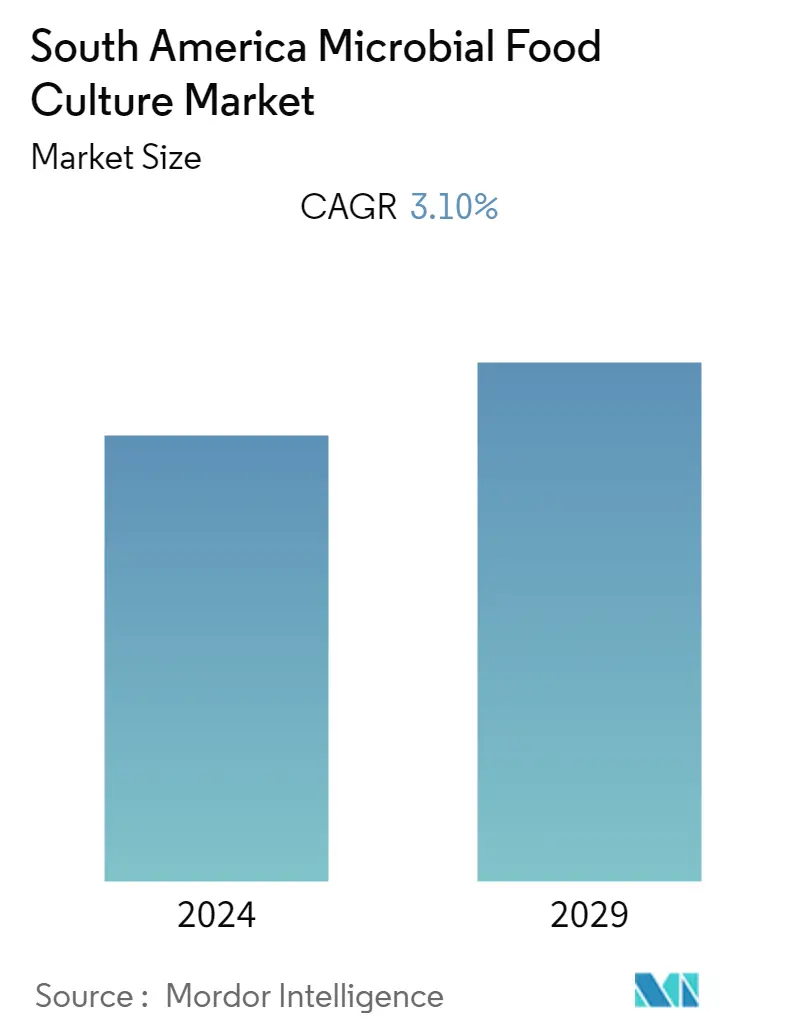Market Size of South America Microbial Food Culture Industry

| Study Period | 2019 - 2029 |
| Base Year For Estimation | 2023 |
| Forecast Data Period | 2024 - 2029 |
| Historical Data Period | 2019 - 2022 |
| CAGR | 3.10 % |
| Market Concentration | Medium |
Major Players
*Disclaimer: Major Players sorted in no particular order |
South America Microbial Food Culture Market Analysis
The South America microbial food culture market is projected to grow at a CAGR of 3.1% during the forecast period 2020-2025
- The market is majorly driven by the rising growing consumer demand for fermented and functional foods, and its wide range of applications in industries such as yogurt, cheese, butter, fermented drinks, and many more. The large demand for microbial food culture in the food industries is due to its functional properties that improve the overall quality and shelf life of the product without any degradation of sensitive ingredients is expected to further strengthen its demand.
- Furthermore, increasing technological advancement in processing and frequent product launch of new ingredient offerings is expected to propel the microbial food culture market growth in the region.
South America Microbial Food Culture Industry Segmentation
The South America microbial food culture market is segmented by type and its application in end-user industries. By type, the market is segmented into starter cultures, adjunct and aroma cultures, and probiotics; and by application into bakery and confectionery, dairy, fruits and vegetables, beverages, and other end-user industries. Also, the study provides an analysis of the microbial food culture market in the emerging and established markets across South America, including Brazil, Argentina, and the Rest of South America.
| By Type | |
| Starter Cultures | |
| Adjunct and Aroma Cultures | |
| Probiotics |
| By End-Industry | |
| Bakery and Confectionery | |
| Dairy | |
| Fruits and Vegetables | |
| Beverages | |
| Other End-user Industries |
| By Country | |
| Brazil | |
| Argentina | |
| Rest of South America |
South America Microbial Food Culture Market Size Summary
The South America microbial food culture market is experiencing growth driven by increasing consumer demand for fermented and functional foods. These cultures are widely applied in the production of yogurt, cheese, butter, and fermented drinks, among others, due to their ability to enhance product quality and extend shelf life without degrading sensitive ingredients. Technological advancements in processing and the frequent introduction of new ingredient offerings are further propelling market growth. The rising consumption of fermented foods, valued for their preservation and sensory qualities, has significantly increased the use of starter cultures in the food and beverage industries. These cultures are essential in producing dairy products, baked goods, and alcoholic beverages, contributing to the market's positive trajectory in terms of value and volume.
Argentina is poised for rapid growth within the South American microbial food culture market, driven by changing dietary patterns and a shift towards healthier eating habits. The demand for processed and ready-to-eat products is on the rise, with microbial food cultures playing a crucial role in enhancing the quality of various fermented foods, including dairy, bakery, beverages, and meat products. The market is competitive, with numerous domestic and multinational players vying for market share. Companies are focusing on mergers, expansions, acquisitions, and partnerships, alongside new product development, to strengthen their market presence. Key players in the region include Koninklijke DSM NV, Corbion NV, Lallemand Inc., and Chr. Hansen Holding AS, among others.
South America Microbial Food Culture Market Size - Table of Contents
-
1. MARKET DYNAMICS
-
1.1 Market Drivers
-
1.2 Market Restraints
-
1.3 Porter's Five Forces Analysis
-
1.3.1 Threat of New Entrants
-
1.3.2 Bargaining Power of Buyers/Consumers
-
1.3.3 Bargaining Power of Suppliers
-
1.3.4 Threat of Substitute Products
-
1.3.5 Intensity of Competitive Rivalry
-
-
-
2. MARKET SEGMENTATION
-
2.1 By Type
-
2.1.1 Starter Cultures
-
2.1.2 Adjunct and Aroma Cultures
-
2.1.3 Probiotics
-
-
2.2 By End-Industry
-
2.2.1 Bakery and Confectionery
-
2.2.2 Dairy
-
2.2.3 Fruits and Vegetables
-
2.2.4 Beverages
-
2.2.5 Other End-user Industries
-
-
2.3 By Country
-
2.3.1 Brazil
-
2.3.2 Argentina
-
2.3.3 Rest of South America
-
-
South America Microbial Food Culture Market Size FAQs
What is the current South America Microbial Food Culture Market size?
The South America Microbial Food Culture Market is projected to register a CAGR of 3.10% during the forecast period (2024-2029)
Who are the key players in South America Microbial Food Culture Market?
Koninklijke DSM NV, Corbion NV, Lallemand Inc., Chr. Hansen Holding AS and IGEA s.r.l. are the major companies operating in the South America Microbial Food Culture Market.

